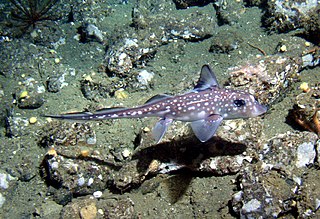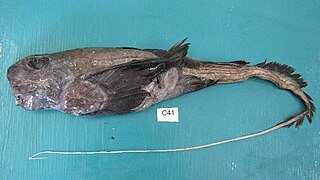
Chimaeras are cartilaginous fish in the order Chimaeriformes, known informally as ghost sharks, rat fish, spookfish, or rabbit fish; the last three names are not to be confused with rattails, Opisthoproctidae, or Siganidae, respectively.

Holocephali, sometimes given the term Euchondrocephali, is a subclass of cartilaginous fish in the class Chondrichthyes. The earliest fossils are of teeth and come from the Devonian period. Little is known about these primitive forms, and the only surviving group in the subclass is the order Chimaeriformes.

Ischyodus is an extinct genus of chimaera. It is the most diverse and long-lived chimaera genus, with over 39 species found worldwide spanning over 140 million years from the Middle Jurassic to the Miocene. Complete specimens of I. quenstedti from the Late Jurassic of Germany most closely resemble the genus Callorhinchus amongst living chimaera genera. It is sometimes placed in the "Edaphodontidae", a unclearly defined group of chimaera with an uncertain position within the clade, while other authors place it into Callorhinchidae along with Callorhinchus.
The pale ghost shark is a shortnose chimaera of the family Chimaeridae. It is endemic to New Zealand waters.
The narrownose chimaera is a longnose chimaera of the family Rhinochimaeridae, the longnose chimaeras, consisting of eight species belonging three genera. This species is found in temperate seas worldwide, at depths between 200 and 3,100 m. Its length is between 1.0 and 1.5 m, including a long, tapering snout and a long, filamentous tail.
Edaphodon was a fish genus of the family Callorhinchidae. As a member of the Chimaeriformes, Edaphodon was a type of rabbitfish, a cartilaginous fish related to sharks and rays. The genus appeared in the Aptian age of the Lower Cretaceous and vanished in the Pliocene. It was most prominent during the Late Cretaceous. Many Edaphodon species were found in the Northern Hemisphere, but species from the Southern Hemisphere are also known.

The African chimaera is a species of fish in the family Chimaeridae found near Kenya, Mozambique, Namibia, and South Africa. Its natural habitat is deep-waters up to the depth of 750 m Eight species of chimaera are found in the southern African region, representing the three families and all six genera.

Hydrolagus is a genus of fish in the family Chimaeridae found in the Atlantic, Indian and Pacific Oceans.

The Chimaeridae, or short-nosed chimaeras, are a family of cartilaginous fish.
The Eastern Pacific black ghostshark is a species of fish in the family Chimaeridae. Despite its name, it does not belong to the clade Selachii used for the modern classification of sharks. It is, however, distantly related to the sharks in the sense that both are Chondrichthyes.

Hydrolagus pallidus is a marine species of fish in the family Chimaeridae found in the Northeast Atlantic Ocean, specifically near Iceland and the Canary Islands. It is commonly known as the pale chimaera or pale ghost shark, although it is not a true shark. Its natural habitat is deepwater seas and near the mid-Atlantic ridge. H. pallidus is found at a depth range of 800 - 3650 m. This species faces a potential threat as bycatch of deepwater trawl fisheries especially as deepwater fisheries operate at greater depths. It has been recognized as distinct from Hydrolagus affinis, its closest relative, since 1990.
Chimaera bahamaensis, commonly known as the Bahamas ghost shark, is a species of fish in the family Chimaeridae. It is found in North Atlantic Ocean around the Bahamas, specifically it has been found east of Andros Island. Chimaera bahamaensis is known to inhabit marine waters from a depth range of 1,483 metres (4,865 ft) – 1,506 metres (4,941 ft). It is one of the most recently described members of the genus Chimaera and to date only a single specimen has been found.
Dwykaselachus is an extinct genus of symmoriiform, a cartilaginous fish that lived in what is now South Africa during the Permian period around 280 million years ago. It was first discovered in the 1980s, in a nodule of sediments from the Karoo Supergroup. Dwykaselachus was named based on Dwyka Group, the group of sedimentary geological formation in the southeastern part of Africa. It represents the place where the type species Dwykaselachus oosthuizeni was found.
The cape chimaera is a chimaera species in the family Chimaeridae, which lives in South Africa and Namibia.
The opal chimaera is a chimaera species in the family Chimaeridae, which lives in the northeastern Atlantic Ocean.

The whitespot ghost shark is a chimaera species in the family Chimaeridae, which lives in parts of the Galápagos Islands in the southeast Pacific Ocean. It lives in waters with steep slopes and boulders and grows to a total length of around 40–50 cm (16–20 in).
The Galápagos ghostshark is a chimaera species in the family Chimaeridae, likely endemic to the Galápagos Islands. It was discovered by John E. McCosker in 1995 and described in 2006, scientifically named in honor of McCosker. This chimaera has a brown compressed, elongate body. The holotype and paratype of the species, both juvenile females, had a total length of 38.1 centimetres (15.0 in) and 22.7 centimetres (8.9 in), respectively. It lives in rocky habitats close to the sea floor, in waters about 395–510 metres (1,296–1,673 ft) deep. It is listed as least concern on the IUCN Red List.
Hydrolagus erithacus, or Robin's ghostshark, is a species of fish in the family Chimaeridae. It is found in the southeastern Atlantic and southwestern Indian oceans.

Chimaera carophila, the brown chimaera is in the subclass of holocephali. It is a marine cartilaginous fish that resides in the Southwest Pacific Ocean surrounding New Zealand. C. carophila was first observed in 2014. The Brown chimaera has notable features such as large eyes, a relatively short first dorsal fin and spine, a soft rounded snout, and a pale brown body color.








